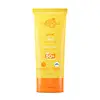What's inside
What's inside
 Key Ingredients
Key Ingredients

 Benefits
Benefits

 Concerns
Concerns

No concerns
 Ingredients Side-by-side
Ingredients Side-by-side

Water
Skin ConditioningIsododecane
EmollientPropylene Glycol
HumectantButyl Methoxydibenzoylmethane
UV AbsorberTerephthalylidene Dicamphor Sulfonic Acid
UV AbsorberGlycerin
HumectantEthylhexyl Methoxycinnamate
UV AbsorberMethylene Bis-Benzotriazolyl Tetramethylbutylphenol
UV FilterDecyl Glucoside
CleansingXanthan Gum
EmulsifyingPhenylbenzimidazole Sulfonic Acid
UV AbsorberTriethanolamine
BufferingCaprylic/Capric Triglyceride
MaskingAmmonium Acryloyldimethyltaurate/Vp Copolymer
Tapioca Starch
Dicaprylyl Carbonate
EmollientEthylhexyl Salicylate
UV AbsorberDimethicone
EmollientCyclopentasiloxane
EmollientCetearyl Alcohol
EmollientCeteareth-20
CleansingCetearyl Olivate
Sorbitan Olivate
EmulsifyingPhenoxyethanol
PreservativeEthylhexylglycerin
Skin ConditioningGlyceryl Stearate
EmollientCarica Papaya Fruit Extract
Skin ConditioningGlyceryl Glucoside
HumectantNiacinamide
Smoothing3-O-Ethyl Ascorbic Acid
Skin ConditioningPolyester-7
Skin ConditioningNeopentyl Glycol Diheptanoate
EmollientSodium Polyacrylate
AbsorbentEthoxydiglycol
HumectantHyaluronic Acid
HumectantBiosaccharide Gum-4
Skin Conditioning1,2-Hexanediol
Skin ConditioningCapsicum Annuum Fruit Extract
AntimicrobialTocopheryl Acetate
AntioxidantSodium Gluconate
Skin ConditioningLaminaria Digitata Extract
Skin ProtectingCetyl-Pg Hydroxyethyl Palmitamide
Skin ConditioningCeramide EOP
Skin ConditioningCeramide Ng
Skin ConditioningCeramide NP
Skin ConditioningCeramide As
Skin ConditioningCeramide AP
Skin ConditioningPanthenol
Skin ConditioningBHT
AntioxidantWater, Isododecane, Propylene Glycol, Butyl Methoxydibenzoylmethane, Terephthalylidene Dicamphor Sulfonic Acid, Glycerin, Ethylhexyl Methoxycinnamate, Methylene Bis-Benzotriazolyl Tetramethylbutylphenol, Decyl Glucoside, Xanthan Gum, Phenylbenzimidazole Sulfonic Acid, Triethanolamine, Caprylic/Capric Triglyceride, Ammonium Acryloyldimethyltaurate/Vp Copolymer, Tapioca Starch, Dicaprylyl Carbonate, Ethylhexyl Salicylate, Dimethicone, Cyclopentasiloxane, Cetearyl Alcohol, Ceteareth-20, Cetearyl Olivate, Sorbitan Olivate, Phenoxyethanol, Ethylhexylglycerin, Glyceryl Stearate, Carica Papaya Fruit Extract, Glyceryl Glucoside, Niacinamide, 3-O-Ethyl Ascorbic Acid, Polyester-7, Neopentyl Glycol Diheptanoate, Sodium Polyacrylate, Ethoxydiglycol, Hyaluronic Acid, Biosaccharide Gum-4, 1,2-Hexanediol, Capsicum Annuum Fruit Extract, Tocopheryl Acetate, Sodium Gluconate, Laminaria Digitata Extract, Cetyl-Pg Hydroxyethyl Palmitamide, Ceramide EOP, Ceramide Ng, Ceramide NP, Ceramide As, Ceramide AP, Panthenol, BHT
 Reviews
Reviews

Ingredients Explained
These ingredients are found in both products.
Ingredients higher up in an ingredient list are typically present in a larger amount.
Hyaluronic acid is naturally found in healthy skin. It is a humectant, meaning it draws moisture to your skin.
This ingredient helps hydrate, soothe, and protect the skin.
What makes hyaluronic acid so hydrating? It has the capacity to bind or hold large amounts of water.
Fun fact: It is already naturally found in our bodies, such as the fluids of our eyes and our joints.
Studies find this ingredient to have anti-inflammatory and anti-microbial properties. This can help speed up wound-healing.
Hyaluronic acid can be irritating if the molecule has a low-molecular weight, or if the molecules are small.
One study found low-molecular weight hyaluronic acid to be pro-inflammatory, meaning some people may experience irritation. This is because our bodies use hyaluronic acid in the wound-healing process to signal to our bodies, via irritation, that something needs healing.
The same study found high-molecular weight hyaluronic acid to be anti-inflammatory.
These are some other common types of Hyaluronic Acid:
Learn more about Hyaluronic AcidWater. It's the most common cosmetic ingredient of all. You'll usually see it at the top of ingredient lists, meaning that it makes up the largest part of the product.
So why is it so popular? Water most often acts as a solvent - this means that it helps dissolve other ingredients into the formulation.
You'll also recognize water as that liquid we all need to stay alive. If you see this, drink a glass of water. Stay hydrated!
Learn more about Water